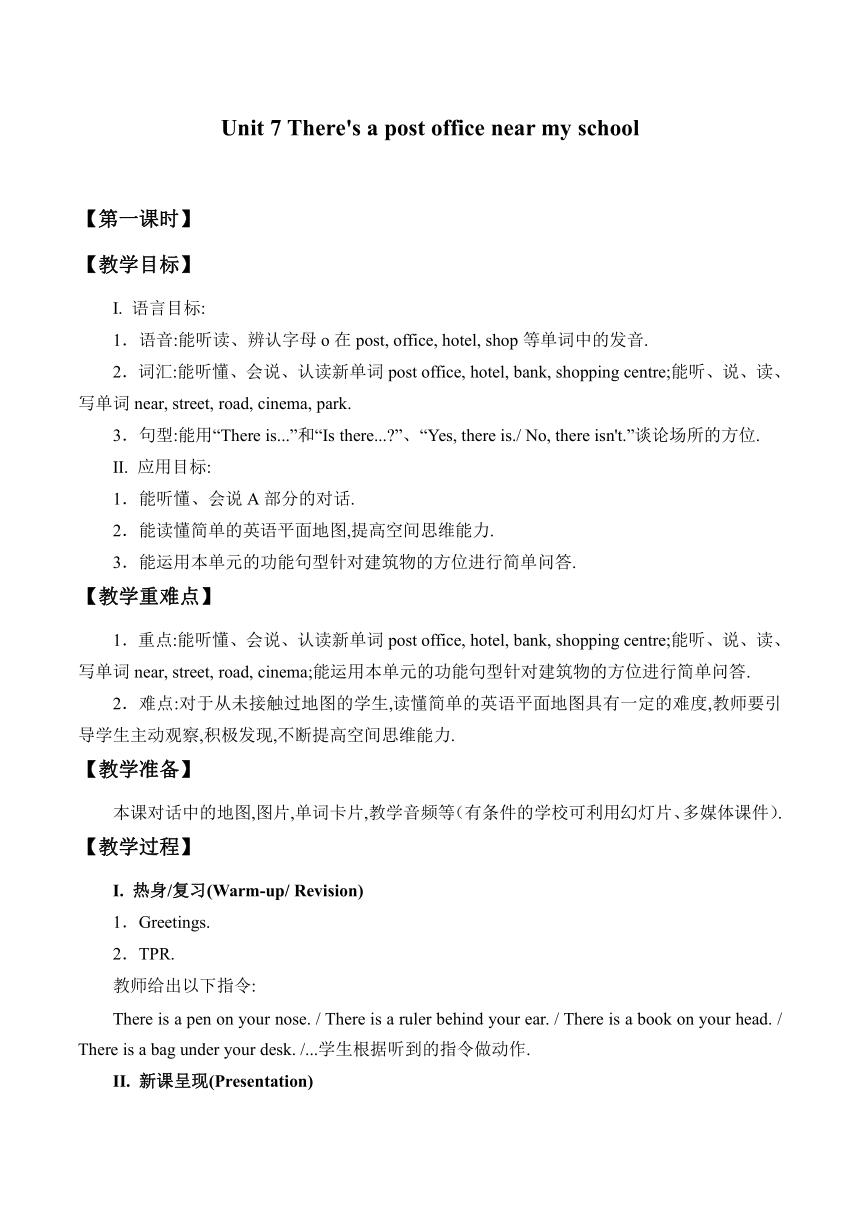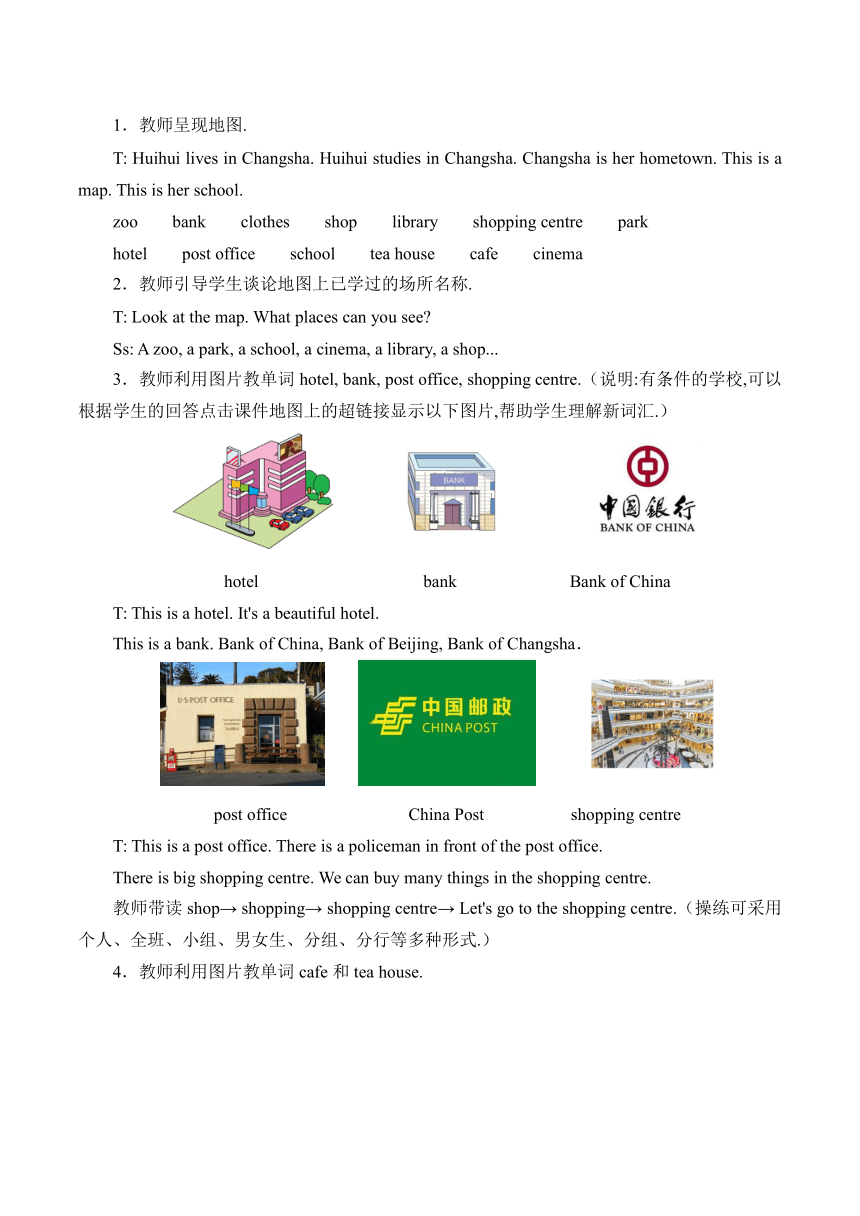Unit 7 There's a post office near my school Period 1 教案
文档属性
| 名称 | Unit 7 There's a post office near my school Period 1 教案 |  | |
| 格式 | doc | ||
| 文件大小 | 1.5MB | ||
| 资源类型 | 教案 | ||
| 版本资源 | 湘少版 | ||
| 科目 | 英语 | ||
| 更新时间 | 2021-07-06 16:02:30 | ||
图片预览


文档简介
Unit 7 There's a post office near my school
【第一课时】
【教学目标】
I. 语言目标:
1.语音:能听读、辨认字母o在post, office, hotel, shop等单词中的发音.
2.词汇:能听懂、会说、认读新单词post office, hotel, bank, shopping centre;能听、说、读、写单词near, street, road, cinema, park.
3.句型:能用“There is...”和“Is there...?”、“Yes, there is./ No, there isn't.”谈论场所的方位.
II. 应用目标:
1.能听懂、会说A部分的对话.
2.能读懂简单的英语平面地图,提高空间思维能力.
3.能运用本单元的功能句型针对建筑物的方位进行简单问答.
【教学重难点】
1.重点:能听懂、会说、认读新单词post office, hotel, bank, shopping centre;能听、说、读、写单词near, street, road, cinema;能运用本单元的功能句型针对建筑物的方位进行简单问答.
2.难点:对于从未接触过地图的学生,读懂简单的英语平面地图具有一定的难度,教师要引导学生主动观察,积极发现,不断提高空间思维能力.
【教学准备】
本课对话中的地图,图片,单词卡片,教学音频等(有条件的学校可利用幻灯片、多媒体课件).
【教学过程】
I. 热身/复习(Warm-up/ Revision)
1.Greetings.
2.TPR.
教师给出以下指令:
There is a pen on your nose. / There is a ruler behind your ear. / There is a book on your head. / There is a bag under your desk. /...学生根据听到的指令做动作.
II. 新课呈现(Presentation)
1.教师呈现地图.
T: Huihui lives in Changsha. Huihui studies in Changsha. Changsha is her hometown. This is a map. This is her school.
zoo bank clothes shop library shopping centre park
hotel post office school tea house cafe cinema
2.教师引导学生谈论地图上已学过的场所名称.
T: Look at the map. What places can you see?
Ss: A zoo, a park, a school, a cinema, a library, a shop...
3.教师利用图片教单词hotel, bank, post office, shopping centre.(说明:有条件的学校,可以根据学生的回答点击课件地图上的超链接显示以下图片,帮助学生理解新词汇.)
hotel bank Bank of China
T: This is a hotel. It's a beautiful hotel.
This is a bank. Bank of China, Bank of Beijing, Bank of Changsha.
post office China Post shopping centre
T: This is a post office. There is a policeman in front of the post office.
There is big shopping centre. We can buy many things in the shopping centre.
教师带读shop→ shopping→ shopping centre→ Let's go to the shopping centre.(操练可采用个人、全班、小组、男女生、分组、分行等多种形式.)
4.教师利用图片教单词cafe和tea house.
tea house cafe
T: We can drink tea in the tea house. We can drink coffee in the cafe.(说明:教师比较coffee和cafe的读音.)
5.教师利用图片教单词road和street.
road road street
T: Can you see the road? It's a long road. All roads lead to Rome. (教师可以用中文解释英语谚语.)
This is a street. (说明:教师要通过图片的对比,讲解road和street的区别.)
6.Game: watch and speak看口型说单词
T: hotel/ tea house/ cafe/ bank/ post office.
III. 课文学习(Learn the text)
1.Listen and answer.
(1)要求学生不打开书,听录音前,给出任务:回答问题.
Who are they? What places can you hear?
(2)学生回答问题.
2.Listen and point.
(1)要求学生不打开书,逐句听录音,并在课件的地图上找到相应的场所位置.
Here is my school.
Is there a park near your school? No, there isn't. But there's a post office.
There's a clothes shop over there.
Is there a cinema around here? Yes, there is. There's a cinema at the end of the street.
There's a tea house.
(说明:在学生逐句听录音的过程中,教师可以借助课件的地图和中文释义的方式逐一处理over there, around, at the end of 等生词和短语.)
(2)要求学生打开书,画出表示场所的单词.
3.Listen and repeat要求学生打开书,听录音,跟读.
4.Say and listen.
学生读一句,然后播放一句录音.
Teaching Tips (1)朗读课文环节,教师先让学生跟读录音,形成语感.
(2)再让学生先读,再放录音,旨在让学生将自己的读音与录音相比较,自我纠正发音.
5.比较字母o在post, office, hotel, shop等单词中的发音.
(1)教师板书单词shop, shopping, office, post, hotel, home, over, clothes, movie.
(2)学生认真朗读,仔细观察,找出字母o在每一个单词中的发音.
教师简单讲解字母o的三种不同发音:[?], [?u], [u:]
IV. 拓展活动(Extension)
1.教师提供地图和语段框架.
Is there...?
Yes, there is. / No, there isn't.
2.学生两人一组,续编对话.
3.学生上台展示,师生评价.
【作业布置】
1.听录音,读对话,并试着表演对话.
2.制作场所和建筑物单词卡片.
常见的场所和建筑物单词
旅馆:hotel 银行:bank
饭店:restaurant 邮局:post office
咖啡馆:cafe 市场:market
公园:park 超市:supermarket
动物园:zoo 商店:shop
世界之窗:Window of the World 购物中心:shopping centre
海底世界:Underwater World 图书馆:library
电影院:cinema 博物馆:museum
【第一课时】
【教学目标】
I. 语言目标:
1.语音:能听读、辨认字母o在post, office, hotel, shop等单词中的发音.
2.词汇:能听懂、会说、认读新单词post office, hotel, bank, shopping centre;能听、说、读、写单词near, street, road, cinema, park.
3.句型:能用“There is...”和“Is there...?”、“Yes, there is./ No, there isn't.”谈论场所的方位.
II. 应用目标:
1.能听懂、会说A部分的对话.
2.能读懂简单的英语平面地图,提高空间思维能力.
3.能运用本单元的功能句型针对建筑物的方位进行简单问答.
【教学重难点】
1.重点:能听懂、会说、认读新单词post office, hotel, bank, shopping centre;能听、说、读、写单词near, street, road, cinema;能运用本单元的功能句型针对建筑物的方位进行简单问答.
2.难点:对于从未接触过地图的学生,读懂简单的英语平面地图具有一定的难度,教师要引导学生主动观察,积极发现,不断提高空间思维能力.
【教学准备】
本课对话中的地图,图片,单词卡片,教学音频等(有条件的学校可利用幻灯片、多媒体课件).
【教学过程】
I. 热身/复习(Warm-up/ Revision)
1.Greetings.
2.TPR.
教师给出以下指令:
There is a pen on your nose. / There is a ruler behind your ear. / There is a book on your head. / There is a bag under your desk. /...学生根据听到的指令做动作.
II. 新课呈现(Presentation)
1.教师呈现地图.
T: Huihui lives in Changsha. Huihui studies in Changsha. Changsha is her hometown. This is a map. This is her school.
zoo bank clothes shop library shopping centre park
hotel post office school tea house cafe cinema
2.教师引导学生谈论地图上已学过的场所名称.
T: Look at the map. What places can you see?
Ss: A zoo, a park, a school, a cinema, a library, a shop...
3.教师利用图片教单词hotel, bank, post office, shopping centre.(说明:有条件的学校,可以根据学生的回答点击课件地图上的超链接显示以下图片,帮助学生理解新词汇.)
hotel bank Bank of China
T: This is a hotel. It's a beautiful hotel.
This is a bank. Bank of China, Bank of Beijing, Bank of Changsha.
post office China Post shopping centre
T: This is a post office. There is a policeman in front of the post office.
There is big shopping centre. We can buy many things in the shopping centre.
教师带读shop→ shopping→ shopping centre→ Let's go to the shopping centre.(操练可采用个人、全班、小组、男女生、分组、分行等多种形式.)
4.教师利用图片教单词cafe和tea house.
tea house cafe
T: We can drink tea in the tea house. We can drink coffee in the cafe.(说明:教师比较coffee和cafe的读音.)
5.教师利用图片教单词road和street.
road road street
T: Can you see the road? It's a long road. All roads lead to Rome. (教师可以用中文解释英语谚语.)
This is a street. (说明:教师要通过图片的对比,讲解road和street的区别.)
6.Game: watch and speak看口型说单词
T: hotel/ tea house/ cafe/ bank/ post office.
III. 课文学习(Learn the text)
1.Listen and answer.
(1)要求学生不打开书,听录音前,给出任务:回答问题.
Who are they? What places can you hear?
(2)学生回答问题.
2.Listen and point.
(1)要求学生不打开书,逐句听录音,并在课件的地图上找到相应的场所位置.
Here is my school.
Is there a park near your school? No, there isn't. But there's a post office.
There's a clothes shop over there.
Is there a cinema around here? Yes, there is. There's a cinema at the end of the street.
There's a tea house.
(说明:在学生逐句听录音的过程中,教师可以借助课件的地图和中文释义的方式逐一处理over there, around, at the end of 等生词和短语.)
(2)要求学生打开书,画出表示场所的单词.
3.Listen and repeat要求学生打开书,听录音,跟读.
4.Say and listen.
学生读一句,然后播放一句录音.
Teaching Tips (1)朗读课文环节,教师先让学生跟读录音,形成语感.
(2)再让学生先读,再放录音,旨在让学生将自己的读音与录音相比较,自我纠正发音.
5.比较字母o在post, office, hotel, shop等单词中的发音.
(1)教师板书单词shop, shopping, office, post, hotel, home, over, clothes, movie.
(2)学生认真朗读,仔细观察,找出字母o在每一个单词中的发音.
教师简单讲解字母o的三种不同发音:[?], [?u], [u:]
IV. 拓展活动(Extension)
1.教师提供地图和语段框架.
Is there...?
Yes, there is. / No, there isn't.
2.学生两人一组,续编对话.
3.学生上台展示,师生评价.
【作业布置】
1.听录音,读对话,并试着表演对话.
2.制作场所和建筑物单词卡片.
常见的场所和建筑物单词
旅馆:hotel 银行:bank
饭店:restaurant 邮局:post office
咖啡馆:cafe 市场:market
公园:park 超市:supermarket
动物园:zoo 商店:shop
世界之窗:Window of the World 购物中心:shopping centre
海底世界:Underwater World 图书馆:library
电影院:cinema 博物馆:museum
同课章节目录
- Unit 1 We are going to read stories.
- Unit 2 We are going to do some research.
- Unit 3 Let's make a kite.
- Assessment Ⅰ
- Unit 4 Don't talk here.
- Unit 5 When’s your birthday?
- Unit 6 I'll make a beautiful card.
- Assessment Ⅱ
- Unit 7 There's a post office near my school.
- Unit 8 Can you show me the way to the xin hua Hote
- Unit 9 He's kind to Children.
- Assessment Ⅲ
- Unit 10 Where were you yesterday?
- Unit 11 Who was first?
- Unit 12 Where did you go?
- Assessment Ⅳ
